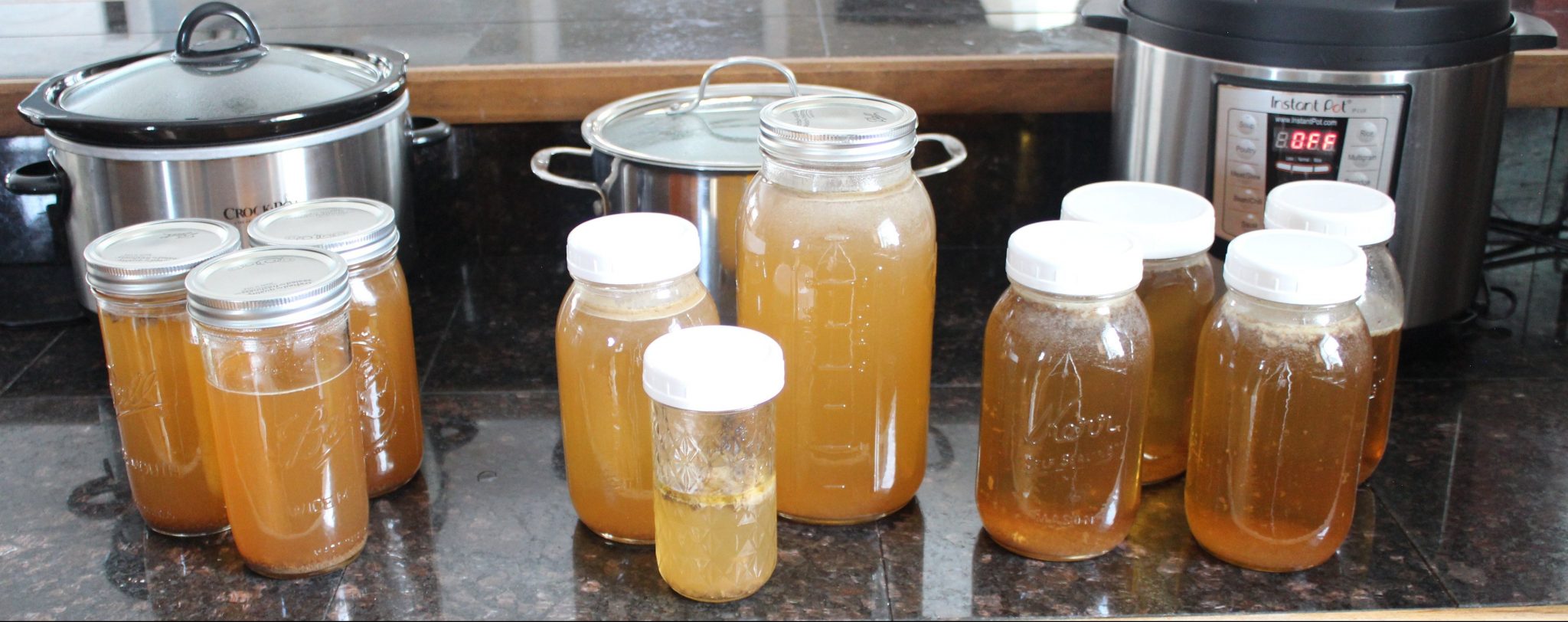
Grassfed organic beef stock, rich in amino acids from the beef bones, collagen, and meat; rich in vitamins and minerals from the produce scraps and sea salt; and rich in phytonutrients from ginger and garlic! This amazing gut-healing health-giving food is nearly free to make, and takes very little time.
Here are recipes for any appliance that you may have- the stock pot, slow cooker, or new favorite- the Instant Pot! The video below goes into detail of the process in each of these methods. Comparing them side by side gives you an idea of which method works best for your situation.
Which is best?
Instant Pot beef stock is quick to set up, completely contained, and you can even move the Instant Pot to another room if you need to free up counter space. It is the fastest of all these methods, and it still produces a delicious highly-nourishing broth.
Read: Is the Instant Pot Safe?
I use all these methods to make beef stock in my own kitchen depending on what else I have going in other appliances.
Bulk cooking, or cooking many things at once to eat over the next few days, is a popular activity in many homes. Appliance flexibility is key to getting all the food made at one time. Depending on what else you’re cooking, any of these stock-making methods can be employed.
For example, you could have yogurt going in your stock pot and beans going in your Instant Pot, so the slow cooker is the best option for making stock at the same time.
Another day you might be making pot roast in the slow cooker and roasting veggies for soup in the oven, so your Instant Pot is free to make stock- and because the Instant Pot is so fast, your stock will be ready at the same time your veggies are roasted.
More: Read about organizing your freezer cooking time here.
Energy Use
When comparing methods, energy use is another consideration. To compare apples to apples, we compare the total energy usage (not hourly) of making stock for each method. Cost shown reflects 12 cents per kwh, the average cost in the US, and $3 per thousand cubic feet of natural gas.
- An electric stovetop, large burner, for 120 minutes uses 1.6 kw, $0.19 (source)
- Gas stovetop for 120 minutes coming in using 24,000 BTU, or .24 thousand cubic feet, or $0.72 (source) (source) *note, I’m not sure if this reflects a stovetop on high heat or low heat, the price may be less. I had always heard that gas was less expensive than electric, but this is not showing that at all. If you want to check my math I’d love to see what you think in the comments.
- In this method I leave my slow cooker on for approximately 18 hours. Eighteen hours to run a slow cooker uses 1.8 kw, $0.22 (source)
- The Instant Pot was set to 90 minutes, but we’ll add another 30 since we also used the Saute function and it was using energy before it actually came to pressure. Since the pressure cooker cycles off, like the oven, to keep a consistent temperature we are assuming that of the 90 minutes that the IP is cooking, it is only ‘on’ 60% of this time. So 30 minutes of being on, plus .6*90= 54 minutes of being on, which we will just round to an hour.
This 60 minutes of the pressure cooker being *on* uses 1 kw, or $0.12 (source)
The Instant Pot is coming out on top, yet again!
Equipment & Ingredients
You will need this equipment for any method:
- Collander
- Funnel (optional)
- Mason Jars or another container to store your stock in
- BPA-free Lids (optional)
And then you need one of the following:
Size of the Instant Pot, Stock Pot, or Slow Cooker isn’t super important. I have linked to what I own; if you have a larger family you may find that sizing up to a 8 or 10-quart versions rather than 6 or 8-quart versions works best for you. Just increase all ingredients appropriately in the recipes.
You will need these ingredients for any method:
- 1-2 pounds Grassfed Beef Soup Bones (find here) (Oxtail, osso buco, marrow bones, knuckle, shank bones- something that has both bone and meat and lots of that cartilage that will be turned into rich nourishing stock)
- Filtered Water (I use a 1-1/2 gallon Berkey)
- Sea Salt (find here)
- Clean Vegetable Scraps, particularly onion peels to make stock a beautiful golden color (optional)
- 2-3 cloves garlic (optional)
- 1-2 inches ginger root (optional)
Read: The Antiinflammatory Benefits of Ginger Root
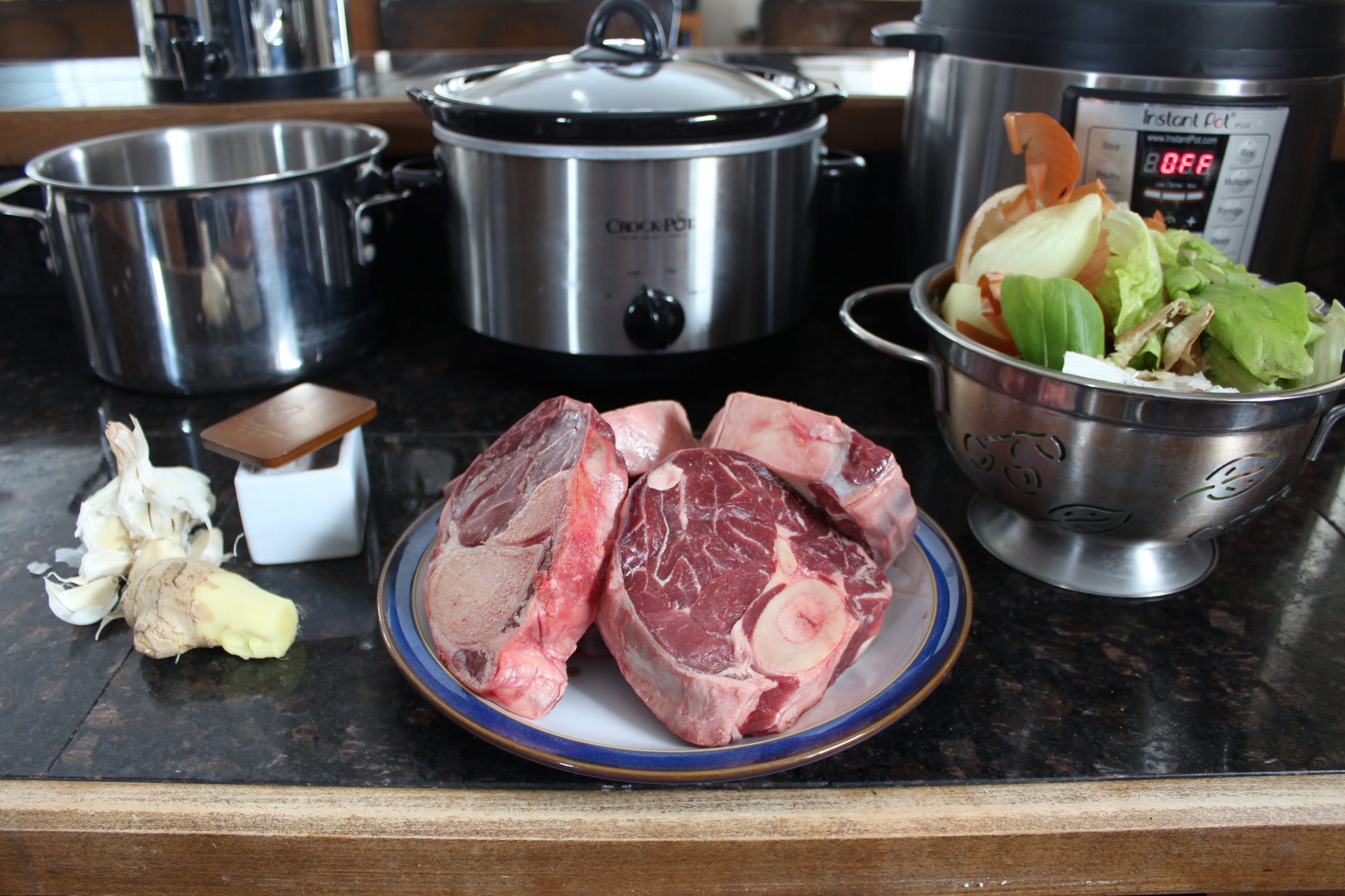
Instant Pot
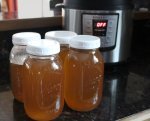
Instant Pot Beef Stock
Ingredients
- 1-2 pounds Grassfed Beef Soup Bones find here
- Filtered Water I use a 1-1/2 gallon Berkey
- Sea Salt find here
- Clean Vegetable Scraps particularly onion peels to make stock a beautiful golden color (optional)
- 2-3 cloves garlic optional
- 1-2 inches ginger root optional
Instructions
-
Turn your Instant Pot to Saute - and Adjust to Medium. Allow pot to preheat for a minute or two, and then addd your soup bones (keep the meat on if they came with meat). Do not use the lid for this step. Allow meat/bones to brown for 10-15 minutes and then turn. Turn Instant Pot off.
-
Add optional vegetable scraps, garlic, ginger, and then fill to the 'max' line on the stainless steel pot with filtered water. Do not add the salt yet.
-
Place lid on and adjust valve to 'seal'. Set Instant Pot to Manual, 90 minutes. Instant pot will come to pressure and then turn off on its own. After cooking, allow pressure to release naturally, this can take up to 30 minutes.
-
Remove lid and allow stock to cool a bit, so it is not so dangerous to pour. Remove meat, bones, and cartilage (save for another batch). Poke marrow out of the middle of the bone and add to your finished stock. Discard vegetable scraps, garlic, and ginger.
-
Pour stock into jars using a funnel, or simmer down (using the Saute feature, uncovered) to reduce the stock as desired. (see more details of this reduction process here)
-
Add salt as desired, I use a scant 1 teaspoon per quart of unreduced stock, which helps preserve the stock but will not become overpowering if the stock is reduced, like in a sauce.
-
Store stock in the refrigerator for up to 3 weeks, or in the freezer for 1 year.
Stock Pot
- 1-2 pounds Grassfed Beef Soup Bones ([url href=”https://healthhomeandhappiness.com/uswellness” target=”_blank” rel=”nofollow”]find here[/url])
- Filtered Water (I use a 1-1/2 gallon [url href=”http://www.bigberkeywaterfilters.com/affiliates/aff_tools/carafaus/tool/text_links/1″ target=”_blank” rel=”nofollow”]Berkey[/url])
- Sea Salt ([url href=”https://healthhomeandhappiness.com/salt” target=”_blank” rel=”nofollow”]find here[/url])
- Clean Vegetable Scraps, particularly onion peels to make stock a beautiful golden color (optional)
- 2-3 cloves garlic (optional)
- 1-2 inches ginger root (optional)
- Heat your stock pot on a large burner over medium-high heat. Allow pot to preheat for a minute or two, and then addd your soup bones (keep the meat on if they came with meat). Do not use the lid for this step. Allow meat/bones to brown for 10-15 minutes and then turn.
- Add optional vegetable scraps, garlic, ginger, and then fill stock pot 3/4 full with filtered water. Do not add the salt yet.
- Bring to a boil over medium-high heat, and then reduce to a simmer (this is about a ‘2’ on my stove, you’ll get to know what is a simmer on your stove, they all vary a bit). Once stock is on a low simmer, cover to keep heat in and reduce cooking time by a little bit.
- Simmer for 3-12 hours, as desired. Stock is done when it is a rich golden color, and all vegetable scraps are well cooked, and cartilage on the marrow bone is starting to soften. Cooking the stock longer will extract more beneficial amino acids from the cartilage surrounding the bones.
- Remove lid and allow stock to cool a bit, so it is not so dangerous to pour. Remove meat, bones, and cartilage (save for another batch). Poke marrow out of the middle of the bone and add to your finished stock. Discard vegetable scraps.
- Pour stock into jars using a funnel, or simmer down to reduce the stock as desired. (see more details of this reduction process [url href=”https://healthhomeandhappiness.com/always-have-broth-on-hand-with-easy-homemade-broth-gelatin-cubes-in-your-freezer.html” target=”_blank”]here[/url].
- Add salt as desired, I use a scant 1 teaspoon per quart of unreduced stock, which helps preserve the stock but will not become overpowering if the stock is reduced, like in a sauce.
- Store stock in the refrigerator for up to 3 weeks, or in the freezer for 1 year.
Slow cooker

Slow Cooker Beef Stock
Ingredients
- 1-2 pounds Grassfed Beef Soup Bones find here
- Filtered Water I use a 1-1/2 gallon Berkey
- Sea Salt find here
- Clean Vegetable Scraps particularly onion peels to make stock a beautiful golden color (optional)
- 2-3 cloves garlic optional
- 1-2 inches ginger root optional
Instructions
-
Place soup bones in slow cooker. Add optional vegetable scraps, garlic, ginger, and then fill ceramic crock 3/4 full with filtered water. Do not add the salt yet.
-
Turn slow cooker to low and allow to cook 8-24 hours, as desired. Stock is done when it is a rich golden color, and all vegetable scraps are well cooked, and cartilage on the marrow bone is starting to soften. Cooking the stock longer will extract more beneficial amino acids from the cartilage surrounding the bones.
-
Turn slow cooker off and allow stock to cool a bit, so it is not so dangerous to pour. Remove meat, bones, and cartilage (save for another batch). Poke marrow out of the middle of the bone and add to your finished stock. Discard vegetable scraps.
-
Pour stock into jars using a funnel, or simmer down to reduce the stock as desired. (see more details of this reduction process here.
-
Add salt as desired, I use a scant 1 teaspoon per quart of unreduced stock, which helps preserve the stock but will not become overpowering if the stock is reduced, like in a sauce.
-
Store stock in the refrigerator for up to 3 weeks, or in the freezer for 1 year.
Comparing the Beef Stock Results
As you can see in the picture at the top of this post and the video, the finished stock had slightly different qualities from each appliance.
- Instant Pot stock is the most clear, presumably because the pressure involved keeps the hot hot stock from vigorously boiling.
- The stock pot stock is most cloudy, as above, because the simmering broke apart small parts of the meat and vegetables, and some air has been incorporated as well.
- The slow cooker stock, despite its longer cook time, produced stock that was lighter than Instant Pot. This could be due to including less onion peels, or because we didn’t brown the meat before covering with water.
- All beef stocks were equally delicious, had equal fat content at the top after chilling, and had equal gelling properties.
- All the beef meat/cartilage/bones were saved for reuse and there did not appear to be any noticeable difference in the quality of them between the appliances.
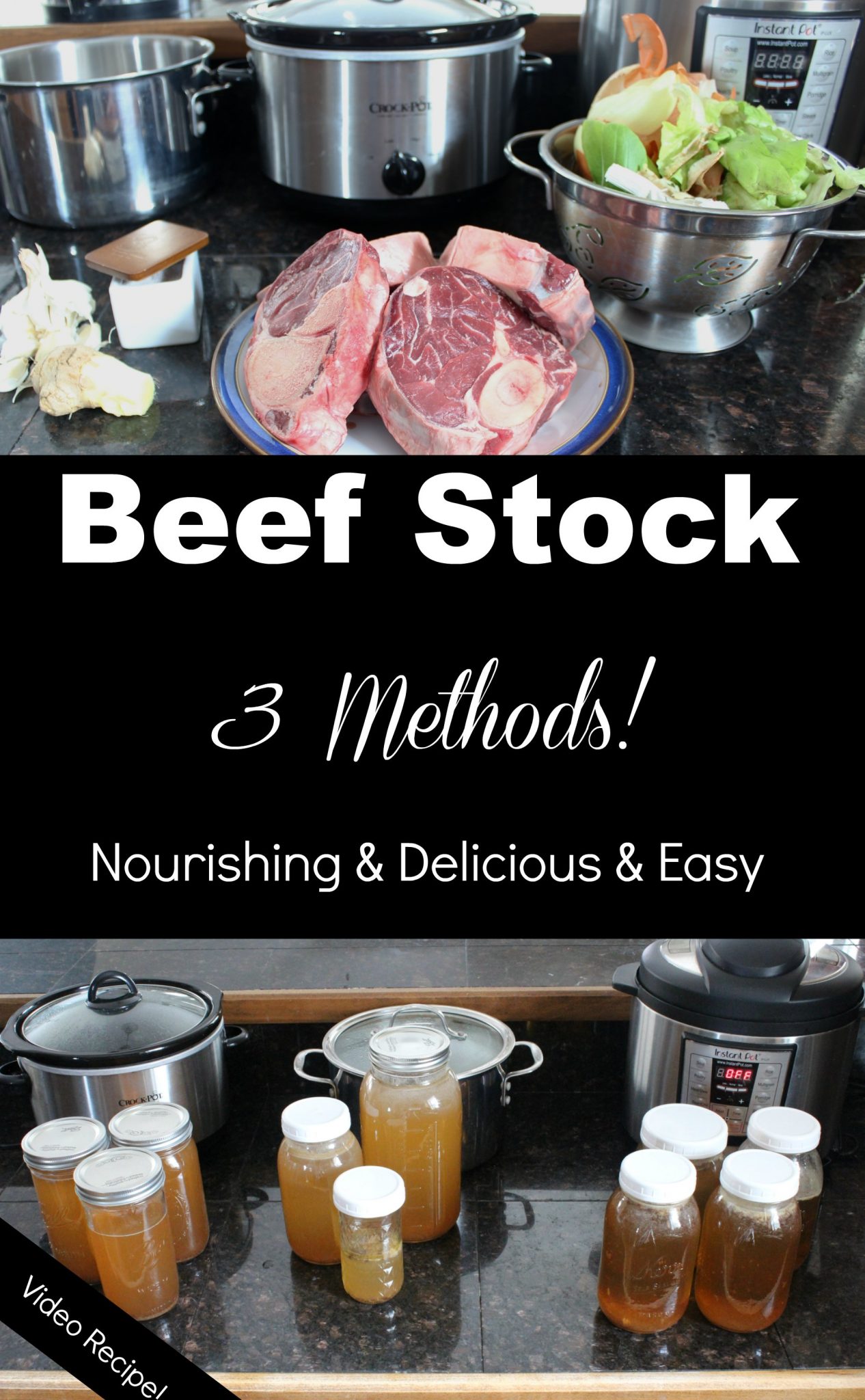
Learn how to heal leaky gut

60-page ebook of all my best GAPS Diet (Gut and Psychology Syndrome) articles all in one place.

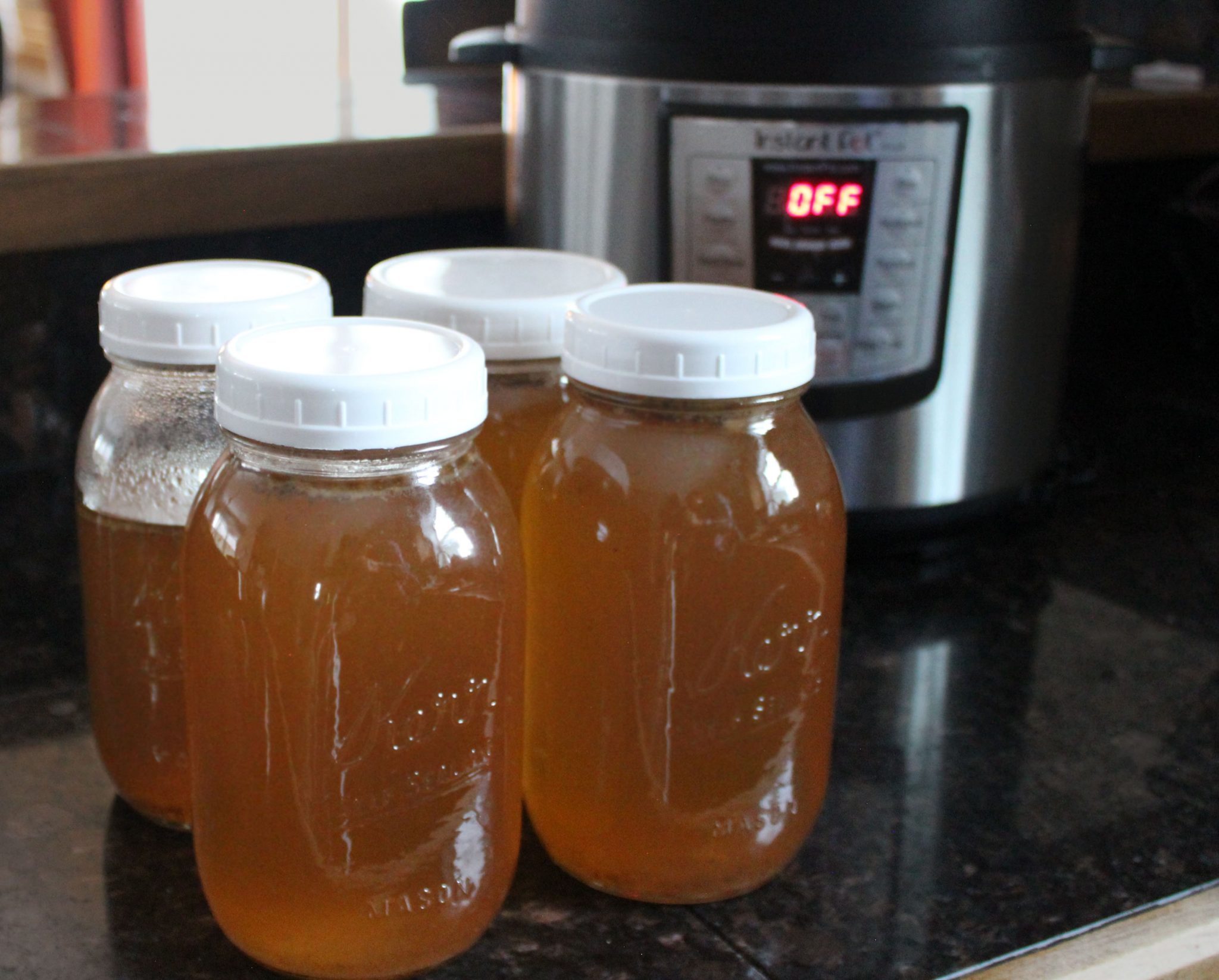


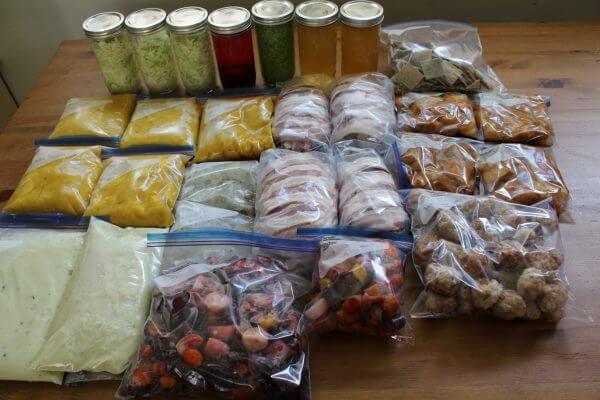

It’s my understanding that pressure cooking is not GAPS legal because it is unknown whether and to what extent the proteins in the food are altered. Looks like a much easier and quicker way to make stock though!
Hi Carrie, That is true! I did talk about GAPS and pressure cooking here if you’d like to see.
Does your starter package include the items in the “30 days on gaps?” I’m still deciding on which package to get.
Hi Eva, it does! :)
Does the process differ for a whole chicken instead of beef bones? Would it still be 90 minutes?
You won’t get much stock out of a whole chicken in the Instant Pot because the chicken takes up so much room :) I’d quarter it, and then it would be the same. If you want to do a whole chicken anyway, yes, 90 minutes should still be good!
Hi, you mention to save the bones for another batch? How many times would you reuse the bones?
Cara, I just restarted the gaps diet after being inconsistently on it. My food slides to groin on ingestion. The no plant gaps diet was recommended to me but it sounds scary for meat and stock to be sliding to my groin. Could you explain the no plant gaps diet , what it’s supposed to do and possibly connect me with someone who has done it? Thank you. Carol
Hi, you seem to be conflating the meaning of “stock” and “broth.” This makes it very confusing for those following the GAPS protocol. These recipes are for broths. Stocks are cooked for much less time than the ones you have listed. This is a very important differentiation for those doing GAPS. I would suggest that you fix this so as not to mislead people and potentially cause harm.
Thanks a bunch